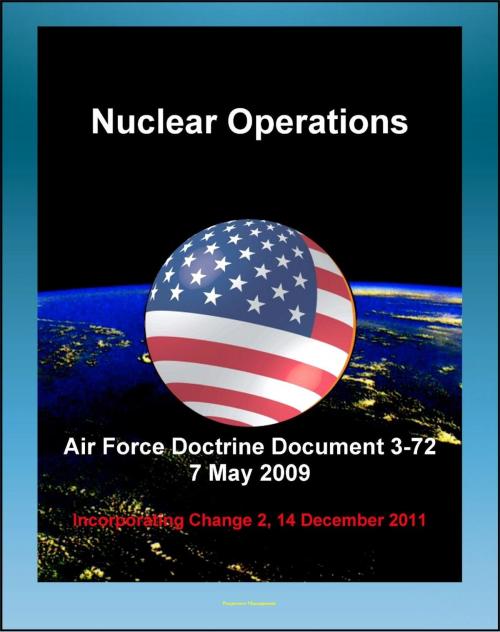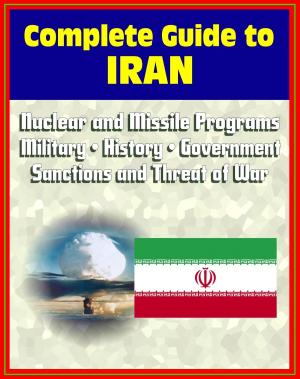Air Force Doctrine Document 3-72: Nuclear Operations - Command and Control (C2), Deterrence, Strategic Effects, Nuclear Safety, Surety, Training
Nonfiction, Science & Nature, Science, Physics, Nuclear Physics, History, Military, Nuclear Warfare| Author: | Progressive Management | ISBN: | 9781476475547 |
| Publisher: | Progressive Management | Publication: | April 19, 2012 |
| Imprint: | Smashwords Edition | Language: | English |
| Author: | Progressive Management |
| ISBN: | 9781476475547 |
| Publisher: | Progressive Management |
| Publication: | April 19, 2012 |
| Imprint: | Smashwords Edition |
| Language: | English |
This publication provides doctrinal guidance for the planning, organizing, and employment of Air Force nuclear forces. The Air Force role in nuclear operations is to organize, train, equip, and sustain forces with the capability to support the national security goals of deterring adversaries from attacking the US and its interests with their nuclear arsenals or other weapons of mass destruction; dissuading competitors from developing WMD; assuring allies and partners of the US' ability and determination to protect them; and holding at risk a specific range of targets. The fundamental purpose of the US nuclear arsenal is to deter an enemy's use of its nuclear arsenal or other weapons of mass destruction.
The threat of global nuclear war has become remote, but the risk of nuclear attack has increased. Maintaining strategic stability will be an important challenge in the years ahead. Russia and China continue to modernize their nuclear capabilities, and both claim US missile defense and conventionally-armed missile programs are destabilizing. The most immediate and extreme threat today is nuclear terrorism. The US should assume that violent extremist organizations that seek nuclear weapons would use them. Additional countries - especially those at odds with the US and its allies and partners, and the broader international community - may acquire nuclear weapons. This doctrine provides guidance for Air Force nuclear operations. It is based on a body of knowledge gained from experience and lessons learned in organizing, training, and equipping nuclear forces in support of national security objectives. The Air Force is responsible for maintaining effective forces with the capability to support national security deterrence goals of deterring adversaries from attacking the US and its interests with their nuclear arsenals or other weapons of mass destruction (WMD); dissuading competitors from developing WMD; assuring allies and partners of the US' ability and determination to protect them; and holding at risk a specific range of targets, while placing great emphasis on the safety and security of our people and the nuclear arsenal. Achieving this in today's environment requires both an in-depth understanding of the modern world and current doctrine built on the foundation of over 60 years of experience in nuclear operations.
Contents: Chapter One - Fundamentals Of Nuclear Operations * Chapter Two - Command And Control Of Nuclear Operations * Chapter Three - Planning And Support Considerations * Chapter Four - Surety * Chapter Five - Training
Credible nuclear deterrence is essential to our security and that of our allies and partners. The Air Force has no mission more sensitive than safeguarding our vital nuclear capabilities and maintaining nuclear deterrence. We must be steadfast in maintaining our nuclear expertise and the highest standards of operational discipline. Uncompromising adherence to standards, personal accountability at all levels, and leadership are the foundations upon which our success depends.
Deterrence is not limited to the threat of attack against the US. The proliferation of weapons of mass destruction (WMD), including nuclear, biological, and chemical weapons and their associated delivery systems, threatens US forces, allies and interests around the world. According to national policy, the US affirms that, for states that possess nuclear weapons and states not in compliance with their nuclear non-proliferation obligations, there remains a discrete range of contingencies in which US nuclear weapons may still play a role in deterring a conventional, chemical, or biological attack against the US or our allies and partners.
This publication provides doctrinal guidance for the planning, organizing, and employment of Air Force nuclear forces. The Air Force role in nuclear operations is to organize, train, equip, and sustain forces with the capability to support the national security goals of deterring adversaries from attacking the US and its interests with their nuclear arsenals or other weapons of mass destruction; dissuading competitors from developing WMD; assuring allies and partners of the US' ability and determination to protect them; and holding at risk a specific range of targets. The fundamental purpose of the US nuclear arsenal is to deter an enemy's use of its nuclear arsenal or other weapons of mass destruction.
The threat of global nuclear war has become remote, but the risk of nuclear attack has increased. Maintaining strategic stability will be an important challenge in the years ahead. Russia and China continue to modernize their nuclear capabilities, and both claim US missile defense and conventionally-armed missile programs are destabilizing. The most immediate and extreme threat today is nuclear terrorism. The US should assume that violent extremist organizations that seek nuclear weapons would use them. Additional countries - especially those at odds with the US and its allies and partners, and the broader international community - may acquire nuclear weapons. This doctrine provides guidance for Air Force nuclear operations. It is based on a body of knowledge gained from experience and lessons learned in organizing, training, and equipping nuclear forces in support of national security objectives. The Air Force is responsible for maintaining effective forces with the capability to support national security deterrence goals of deterring adversaries from attacking the US and its interests with their nuclear arsenals or other weapons of mass destruction (WMD); dissuading competitors from developing WMD; assuring allies and partners of the US' ability and determination to protect them; and holding at risk a specific range of targets, while placing great emphasis on the safety and security of our people and the nuclear arsenal. Achieving this in today's environment requires both an in-depth understanding of the modern world and current doctrine built on the foundation of over 60 years of experience in nuclear operations.
Contents: Chapter One - Fundamentals Of Nuclear Operations * Chapter Two - Command And Control Of Nuclear Operations * Chapter Three - Planning And Support Considerations * Chapter Four - Surety * Chapter Five - Training
Credible nuclear deterrence is essential to our security and that of our allies and partners. The Air Force has no mission more sensitive than safeguarding our vital nuclear capabilities and maintaining nuclear deterrence. We must be steadfast in maintaining our nuclear expertise and the highest standards of operational discipline. Uncompromising adherence to standards, personal accountability at all levels, and leadership are the foundations upon which our success depends.
Deterrence is not limited to the threat of attack against the US. The proliferation of weapons of mass destruction (WMD), including nuclear, biological, and chemical weapons and their associated delivery systems, threatens US forces, allies and interests around the world. According to national policy, the US affirms that, for states that possess nuclear weapons and states not in compliance with their nuclear non-proliferation obligations, there remains a discrete range of contingencies in which US nuclear weapons may still play a role in deterring a conventional, chemical, or biological attack against the US or our allies and partners.















